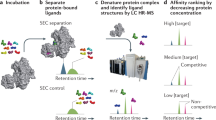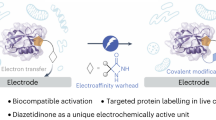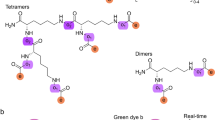Abstract
This protocol describes assay development, validation and implementation of automated immobilized metal affinity for phosphochemicals (IMAP)-based fluorescence polarization (FP) and time-resolved fluorescence resonance energy transfer (TR-FRET) high-throughput screening (HTS) assays for identification of low-molecular-weight kinase inhibitors. Both procedures are performed in miniaturized kinase reaction volumes and involve the stepwise addition of test or control compounds, enzyme and substrate/ATP. Kinase reactions are stopped by subsequent addition of IMAP-binding buffer. Assay attributes of the IMAP FP and TR-FRET methodologies are described. HTS assays developed using these procedures should result in Z-factors and low assay variability necessary for robust HTS assays. Providing that the required reagents and equipment are available, one scientist should be able to develop a 384-well, miniaturized HTS assay in ∼6–8 weeks. Specific automated HTS assay conditions will determine the number of assay plates processed in a screening session, but two scientists should expect to process between 100 and 150 assay plates in one 8-h screening day.
This is a preview of subscription content, access via your institution
Access options
Subscribe to this journal
Receive 12 print issues and online access
$259.00 per year
only $21.58 per issue
Buy this article
- Purchase on Springer Link
- Instant access to full article PDF
Prices may be subject to local taxes which are calculated during checkout




Similar content being viewed by others
References
Inglese, J. et al. High-throughput screening assays for the identification of chemical probes. Nat. Chem. Biol. 3, 466–479 (2007).
Hertzberg, R.P. & Pope, A.J. High-throughput screening: new technology for the 21st century. Curr. Opin. Chem. Biol. 4, 445–451 (2000).
Trinquet, E. & Mathis, G. Fluorescence technologies for the investigation of chemical libraries. Mol. BioSyst. 2, 380–387 (2006).
Pereira, D.A. & Williams, J.A. Origin and evolution of high throughput screening. Br. J. Pharmacol. 152, 53–61 (2007).
Fox, S. et al. High-throughput screening: update of practices and success. J. Biomol. Screen. 11, 864–869 (2006).
Verkman, A.S. Drug discovery in academia. Am. J. Physiol. Cell Physiol. 286, C465–C474 (2004).
Austin, C.P., Brady, L.S., Insel, T.R. & Collins, F.S. NIH Molecular Libraries Initiative. Science 306, 1138–1139 (2004).
Lazo, J.S. Roadmap or roadkill: a pharmacologist's analysis of the NIH Molecular Libraries Initiative. Mol. Interv. 6, 240–241 (2006).
Nwaka, S. & Hudson, A. Innovative lead discovery strategies for tropical diseases. Nat. Rev. Drug Discov. 5, 941–955 (2006).
Madoux, F. et al. Potent, selective and cell penetrant inhibitors of SF-1 by functional uHTS. Mol. Pharmacol. 73, 1776–1784 (2008).
Sharlow, E.R., Leimgruber, S.S., Shun, T.Y. & Lazo, J.S. Development and implementation of miniaturized high throughput time-resolved fluorescence energy transfer assay to identify small molecule inhibitors of polo-like kinase 1. Assay Drug Dev. Technol. 5, 723–735 (2007).
Blume-Jensen, P. & Hunter, T. Oncogenic kinase signaling. Nature 411, 355–365 (2001).
Cohen, P. Protein kinases—the major drug targets of the twenty-first century. Nat. Rev. Drug Discov. 1, 309–315 (2002).
Manning, G., Whyte, D.B., Martinez, R., Hunter, T. & Sudarsanam, S. The protein kinase complement of the human genome. Science 298, 1912–1934 (2002).
Gribbon, P. & Sewing, A. Fluorescence readouts in HTS: no gain without pain? Drug Discov. Today 8, 1035–1043 (2003).
Munagala, N. et al. Identification of small molecule ceramide kinase inhibitors using a homogeneous chemiluminescence high throughput assay. Assay Drug Dev. Technol. 5, 65–73 (2007).
Koresawa, M. & Okabe, T. High-throughput screening with quantitation of ATP consumption: a universal non-radioisotope homogeneous assay for protein kinase. Assay Drug Dev. Technol. 2, 153–160 (2004).
Rykx, A. et al. An enzyme-linked immunosorbent assay for protein kinase D activity using phosphorylation site-specific antibodies. Assay Drug Dev. Technol. 5, 637–643 (2007).
Togame, H., Fuchikami, K., Sagara, A., Inbe, H. & Ziegelbauer, K. Development of a non-radioactive, 384-well format assay to detect inhibitors of the mitogen-activated protein kinase kinase 4. Assay Drug Dev. Technol. 3, 65–76 (2005).
Eggeling, C., Brand, L., Ullmann, D. & Jager, S. Highly sensitive fluorescence detection technology currently available for HTS. Drug Discov. Today 8, 632–641 (2003).
Mallari, R. et al. A generic high-throughput screening assay for kinases: protein kinase A as an example. J. Biomol. Screen. 8, 198–204 (2003).
Pope, A.J., Haupts, U.M. & Moore, K.J. Homogenous fluorescence readouts for miniaturized high-throughput screening: theory and practice. Drug Discov. Today 4, 350–362 (1999).
Kristjansdottir, K. & Rudolph, J. A fluorescence polarization assay for native protein substrates of kinases. Anal. Biochem. 316, 41–49 (2003).
Huss, K.L., Blonigen, P.E. & Campbell, R.M. Development of a Transcreener kinase assay for protein kinase A and demonstration of concordance of data with a filter-binding assay format. J. Biomol. Screen. 12, 578–584 (2007).
Schröter, T. et al. Comparison of miniaturized time-resolved fluorescence resonance energy transfer and enzyme-coupled luciferase high-throughput screening assays to discover inhibitors of Rho-kinase II (ROCK II). J. Biomol. Screen. 13, 17–28 (2008).
Kashem et al. Three mechanistically distinct kinase assays compared: measurements of intrinsic ATPase activity identified the most comprehensive set of ITK inhibitors. J. Biomol. Screen. 12, 70–83 (2007).
Von Ahsen, O., Schmidt, A., Klotz, M. & Parczyk, K. Assay concordance between SPA and TR-FRET in high-throughput screening. J. Biomol. Screen. 11, 606–616 (2006).
Kadkhodayan, S. et al. Evaluation of assay technologies for the identification of protein-peptide interaction antagonists. Assay Drug Dev. Technol. 5, 501–513 (2007).
Rininsland, F. et al. Metal ion-mediated polymer superquenching for highly sensitive detection of kinase and phosphatase activities. Proc. Natl. Acad. Sci. USA 101, 15295–15300 (2004).
Comley, J. Assay interference—a limiting factor in HTS. Drug Discov. World Summer 91–98 (2003).
Gaudet, E.A. et al. A homogeneous fluorescence polarization assay adaptable for a range of protein serine/threonine and tyrosine kinases. J. Biomol. Screen. 8, 164–175 (2003).
Sportsman, J.R., Gaudet, E.A. & Broge, A. Immobilized metal ion affinity-based fluorescence polarization (IMAP): advance in kinase screening. Assay Drug Dev. Technol. 2, 205–214 (2004).
Loomans, E.E., van Doornmalen, A.M., Wat, J.W. & Zaman, G.J. High-throughput screening with immobilized metal ion affinity-based fluorescence polarization detection, a homogeneous assay for protein kinases. Assay Drug Dev. Technol. 1, 445–453 (2003).
Banks, P. & Harvey, M. Considerations for using fluorescence polarization in the screening of G protein-coupled receptors. J. Biomol. Screen. 7, 111–117 (2002).
Sportsman, R. & Gaudet, E. IMAP: detection and quantification of kinase inhibitors. IMAP application Misc: note number 2 http://www.moleculardevices.com/ (2004).
Turek-Etienne, T.C., Kober, T.P., Stafford, J.M. & Bryant, R.W. Development of a fluorescence polarization AKT serine/threonine kinase assay using an immobilized metal ion affinity-based technology. Assay Drug Dev. Technol. 1, 545–553 (2003).
Klumpp, M. et al. Readout technologies for highly miniaturized kinase assays applicable to high-throughput screening in a 1536-well format. J. Biomol. Screen. 11, 617–633 (2006).
Lu, Z. et al. Development of a fluorescence polarization bead-based coupled assay to target different activity/conformation states of a protein kinase. J. Biomol. Screen. 9, 309–321 (2004).
Comley, J. TR-FRET based assays—getting better with age. Drug Discov. World Spring 22–37 (2006).
Strebhardt, K. & Ullrich, A. Targeting polo-like kinase 1 for cancer therapy. Nat. Rev. Cancer 6, 321–330 (2006).
Guimreddy, K. et al. ON01910, a non-ATP-competitive small molecule inhibitor of Plk1, is a potent anticancer agent. Cancer Cell 7, 275–286 (2005).
Steegmaier, M. et al. BI 2536, a potent and selective inhibitor of polo-like kinase 1, inhibits tumor growth in vivo. Curr. Biol. 17, 316–322 (2007).
Wang, Q.J. PKD at the crossroads of DAG and PKC signaling. Trends Pharmacol. Sci. 27, 317–323 (2006).
Avkiran, M., Rowland, A.J., Cuello, F. & Haworth, R.S. Protein kinase D in the cardiovascular system: emerging roles in health and disease. Circ. Res. 102, 157–163 (2008).
Brisson Tierno, M. et al. Development and optimization of high-throughput in vitro protein phosphatase screening assays. Nat. Protoc. 2, 1134–1143 (2007).
Boge, A. TR-FRET detection with IMAP. IMAP application note number 7. http://www.moleculardevices.com/ (2007).
Wu, G., Yuan, Y. & Hodge, C.N. Determining appropriate substrate conversion for enzymatic assays in high-throughput screening. J. Biomol. Screen. 8, 694–700 (2003).
Macarrón, R. & Hertzberg, R.P. Design and implementation of high throughput screening assays. Methods Mol. Biol. 190, 1–29 (2002).
Duan, W. et al. Establishment and application of a high throughput model for rho kinase inhibitors screening based on fluorescence polarization. Biol. Pharm. Bull. 29, 1138–1142 (2006).
Huang, W., Zhang, Y. & Sportsman, J.R. A fluorescence polarization assay for cyclic nucleotide phosphodiesterases. J. Biomol. Screen. 7, 215–222 (2002).
Beasley, J.R., McCoy, P.M., Walker, T.L. & Dunn, D.A. Miniaturized, ultra high throughput screening of tyrosine kinases using homogeneous, competitive fluorescence immunoassays. Assay Drug Dev. Technol. 2, 141–151 (2003).
Zhang, J.H., Chung, T.D. & Oldenburg, K.R. A simple statistical parameter for use in evaluation and validation of high throughput screening assays. J. Biomol. Screen. 4, 67–73 (1999).
Johnston, P.A. et al. HTS identifies novel and specific uncompetitive inhibitors of the two-component NS2B-NS3 proteinase of West Nile virus. Assay Drug Dev. Technol. 5, 737–750 (2007).
Johnston, P.A. et al. Development and implementation of a 384-well homogeneous fluorescence intensity high-throughput screening assay to identify mitogen-activated protein kinase phosphatase-1 dual-specificity protein phosphatase inhibitors. Assay Drug Dev. Technol. 5, 319–332 (2007).
Rhode, H. et al. An improved method for checking HTS/uHTS liquid-handling systems. J. Biomol. Screen. 9, 726–733 (2004).
Acknowledgements
This work was supported by the National Institutes of Health grants R03 DA24898-01, U54 MH074411-03 and X01 MH077611-01. We thank Dr. Paul A. Johnston for his technical advice with respect to HTS assay development and implementation.
Author information
Authors and Affiliations
Corresponding author
Rights and permissions
About this article
Cite this article
Sharlow, E., Leimgruber, S., Yellow-Duke, A. et al. Development, validation and implementation of immobilized metal affinity for phosphochemicals (IMAP)-based high-throughput screening assays for low-molecular-weight compound libraries. Nat Protoc 3, 1350–1363 (2008). https://doi.org/10.1038/nprot.2008.111
Published:
Issue Date:
DOI: https://doi.org/10.1038/nprot.2008.111
Comments
By submitting a comment you agree to abide by our Terms and Community Guidelines. If you find something abusive or that does not comply with our terms or guidelines please flag it as inappropriate.



